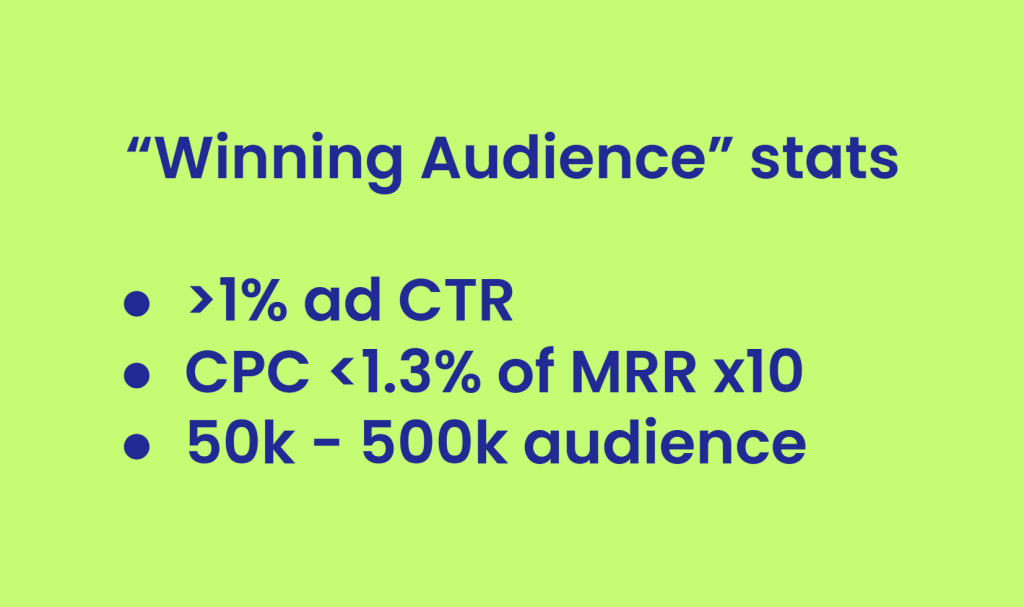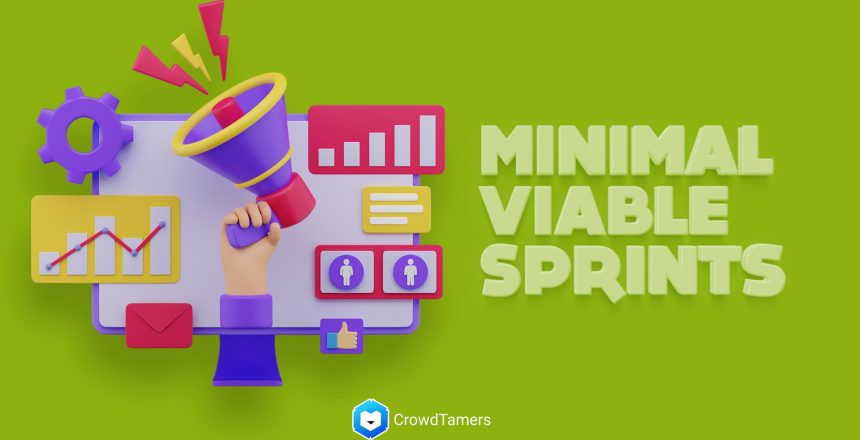So maybe I’m crazy.
But after 5 years of teaching about minimum viable sprints and using it in my marketing practice for virtually every kind of campaign I want to create, 90% of us are approaching new marketing campaigns the wrong way.

When you start a campaign, what do you do?
You write a project brief, right? Then you do all the rest of the work: up front: all the design, copywriting, video creation, landing pages, and social media campaigns are usually created before a marketing campaign is launched based on a project brief.
If you were a systems engineer in 1940’s IBM, this is exactly how you’d write software.
But we’ve, uh, we’ve changed how we write code since then.
Maybe you’ve heard of it: Agile Development. There was a whole revolution. There was a manifesto. We made T-shirts and everything.
And everything from putting people on the moon with the Apollo program to that new mobile app that you love that I’m not cool enough to know about was all built with variations on Agile Development.
So how come marketing, 12 years after Michelle Acardi wrote “Agile Marketing”, is still stuck in the old way? It’s really an inefficient way to launch something new, because of the risk and the rigidity of it.
Waterfall Method in Marketing Campaigns
- Sequential Phases: The waterfall model in marketing involves a linear, step-by-step process. It starts with extensive market research, followed by the creation of a comprehensive project brief, designing campaign elements, launching, and finally, post-launch analysis. Each phase depends on the completion of the previous one.
- Upfront Workload: A significant amount of work, including copywriting, design, video production, and landing page creation, is completed upfront before the campaign is launched.
- Rigidity: Once a phase is completed, it’s challenging to go back and make changes. If the campaign is not resonating with the audience, it often requires starting over or making costly adjustments.
- High Risk: Large investments are made based on assumptions and predictions without real-world testing. This increases the risk of the campaign not achieving its desired outcomes.
- Delayed Feedback: Feedback is often received only after the campaign has been fully launched, further delaying potential course corrections.
Minimum Viable Sprints in Marketing
- Iterative Approach: MVMS adopts an agile approach, where marketing campaigns are broken down into smaller, manageable sprints. Each sprint is focused on testing specific components of a campaign.
- Rapid Prototyping and Testing: Instead of creating all campaign elements upfront, MVMS focuses on quickly developing minimum viable versions of ads, copy, or landing pages and testing them in the real world.
- Flexibility: Feedback from each sprint is used to iterate and improve. If something doesn’t work, it can be swiftly altered or discarded, reducing the cost of failure.
- Reduced Risk: By testing ideas on a smaller scale before full deployment, MVMS significantly reduces the financial and resource-related risks.
- Continuous Improvement and Learning: Real-time feedback allows for continuous learning and improvement of the campaign strategy, leading to more effective and efficient campaigns.
| Waterfall Marketing | Minimum Viable Sprints (MVMS) | |
|---|---|---|
| Flexibility | Low (rigid structure and sequence) | High (adaptable and iterative) |
| Risk | High (due to upfront investment & assumptions) | Lower (incremental testing reduces overall risk) |
| Overall Speed | Faster in initial setup (but slower to pivot) | Slower initial setup, but faster to adapt |
| Cost | Potentially lower upfront, but higher if changes needed | Higher initial costs, but more cost-effective in the long run |
| Workload | Intense initial workload; difficult to manage if changes needed | Spread out; easier to manage due to iterative nature |
| Feedback & Adaptation | Delayed; post-launch | Continuous; real-time adjustments possible |
| Predictability | High (structured plan) | Medium (flexible to changes) |
| Resource Utilization | Can be inefficient (resources may be wasted on untested ideas) | More efficient (resources are allocated based on tested outcomes) |
| Market Responsiveness | Low (challenges in responding to market changes) | High (quick to respond to market feedback) |
| Success Reliability | Lower (high reliance on initial assumptions) | Higher (data-driven decisions) |
Agile Product Development works because you have something to start with – the Minimum Viable Product. It’s the version of the product with every single feature removed that isn’t required to accomplish the simplest version of the goal task at hand. Login can be buggy, social sharing nonexistent, and key account sharing and limitation features missing entirely, but it if does the most important task for the product to accomplish a goal for a person, it’s an MVP.
We don’t have the same thing in marketing.
Until now.
What is the purpose of a marketing campaign?
Marketing raises awareness of a product or service to people who are hopefully interested in using and paying for that product or service. That’s it. That’s the ball game.
So what’s the minimum version of a marketing campaign?
Something that finds a small sample of people who are hopefully interested in your product or service shows them an approach to persuade them to try it. A minimum version of a marketing campaign needs to be developed with very few resources and very minimal funding, and it shouldn’t take long to run or there’s no point to it.
The Minimum Viable (Marketing) Sprint
So here’s a simple thing. It costs $100. It takes 48 hours. And I think it might completely transform how you approach any kind of marketing if you let it.
Let’s start by accepting 3 things:
- Your marketing will work best when you find the audience that is most motivated to buy your product or service.
- Your marketing will work best when you understand exactly what problem motivates your buyer to seek help.
- Your marketing will work best when you have the most compelling offer you can construct to solve that problem.
So a minimum viable sprint is a way to test all of these quickly and affordably to dial in your messaging before you start to spend big on the full marketing campaign that your awesome product or service demands. Here’s what it looks like:
Step 1: Defining the Audience, Problem, and Offer
The first step is identifying the audience, understanding the problem you’re solving for them, and tailoring your offer accordingly. Ideally, you want to assume one thing is fixed—your product offer, usually, although sometimes your audience problem—and then you test variations of the other two variables.
Step 2: Creating your Minimum Viable Marketing Sprints
Define at least 2 audiences. More is fine! Each audience needs a $100 budget and 3 – 5 ads created for them.
But what kind of ad? How involved is it?
Well, let me show you some of the MVS ads we’ve created at CrowdTamers.
You’ll notice a trend: basically, no graphics. Just text.
That’s on purpose. Because you want to speed things up. No design resources today? No worries, anyone with a few fingers and at least one eye can create these. No access to the official brand pack? No problem, there’s basically no branded materials on this ad at all.
We are testing audience <> message fit here, not whether the graphics are appealing.
Yet.
Then when you’re ready with your creative, you’re going to make your ad campaign.
- Campaign Setup:
- Go to Meta Ads Manager and select ‘+Create’.
- Choose ‘Traffic’ as your campaign objective.
- Where are you sending the traffic? The post-click conversion isn’t the focus of this test, so send them wherever you feel is best. Your homepage? Do you already have a good landing page? Wherever you like.
- I generally create a series of ad sets (each of which can have its own audience and targeting) under one campaign. Minimum Viable Sprint 1 aka MVS1 may have 3 – 10 different audiences and tests under it (each with its own ad set), MVS2 will have fewer as I’ve learned from MVS 1, and so on.
- Ad Set Details.
- Name your Ad set, usually by whatever you’re testing. If you’re trying different audiences, then name each ad set by the audience. if you’re trying different offers, make it that.
- Set the buying type to ‘Auction’.
- Audience Targeting:
- In the Audience section, use ‘Interest Targeting’ rather than Advantage+ placement.
- Ensure your audience size is between 50,000 and 500,000. This gets you data but keeps the audience small enough that the results are statistically significant.
- Optional → Placements: Maybe you don’t wanna be on Instagram (or Facebook) for some reason because you know your audience is one place or the other? If you want, you can choose which platform and even whether you’re on desktop or mobile here.
- Choose ‘Manual Placements’ instead of ‘Advantage+ Placements’.
- Select the platforms and placements where you want your ads to appear. This gives you control over where your ads are shown, which is crucial for testing specific audiences.
- Budget and Schedule:
- Budget is $100 per audience.
- The ads should run for 48 hours
- Ad Creation:
- Create 3-4 distinct ads targeted to the same audience group.
- Ensure these ads differ slightly in messaging, imagery, or other creative elements. This variation helps in testing what resonates best with your audience.
- Optimization and Delivery:
- Set your optimization for ad delivery to ‘Link Clicks’ or ‘Landing Page Views’ depending on your specific goals.
- Monitor the Click-Through Rate (CTR) and Cost Per Click (CPC) for insights.
Step 3: Analysis when the MVS is done
You’re looking for 3 key things to find a winning ad.

If you’ve got all 3 of those you’re in the clear. You’re ready to build a more advanced marketing campaign now with graphics, landing pages, and other optimizations. 🙂
Why do these numbers make a “Winning Audience”?
I’ve abstracted away a lot of math here.
Industry average display ads get 0.5% CTR; by earning a 1% CTR (and with ads as rudimentary as a minimum viable sprint which leaves a lot of room for improvement), you are performing at least 1 standard deviation better than the mean.
Combine that with a CPC <1.3% of MRR x 10 (or Average Customer Lifetime Value if you know that instead), and that means that your traffic is interested enough (>1% clickthrough) and cheap enough (<1.3% of ACV) that you will be able to make money once you are sending them to an optimized destination.
What this gets you:
- Audience Discovery: Identifying a target audience that’s substantial enough to sustain your business. This involves trial and error, using platforms like Meta to gauge audience size and engagement.
- Message Experimentation: Running simple ads with varied messaging to different audience segments will quickly find the right rhetorical appeal to make your ads most performative. The focus is on the words and their appeal rather than on flashy designs or visuals.
- Quick Iterative Learning: Based on the responses, refine your audience and messaging for further sprints. You don’t want to run 1 sprint—there’s a reason why they are cheap and fast—you want to run 3 or 5 of them and then build your more finished marketing engines based on what you learn here.
An MVS can help you launch anything
A minimum viable marketing sprint can help you launch anything, from a new product to a new feature, to a new market. You can use it to find your product-market fit, validate your positioning, test your messaging, and optimize your conversion. You can also use it to discover new opportunities and niches that you might not have thought of before. The key is to use a simple and clear appeal, to target a specific and reachable audience, and to measure your click-through rate, cost per click, and audience size. You can then use these metrics to compare and evaluate your different options, and to choose the best one for your business.
Don’t believe me? Try it out yourself. What have you got to lose—$100?
Yeah, but think about what you have to gain. 🙂



